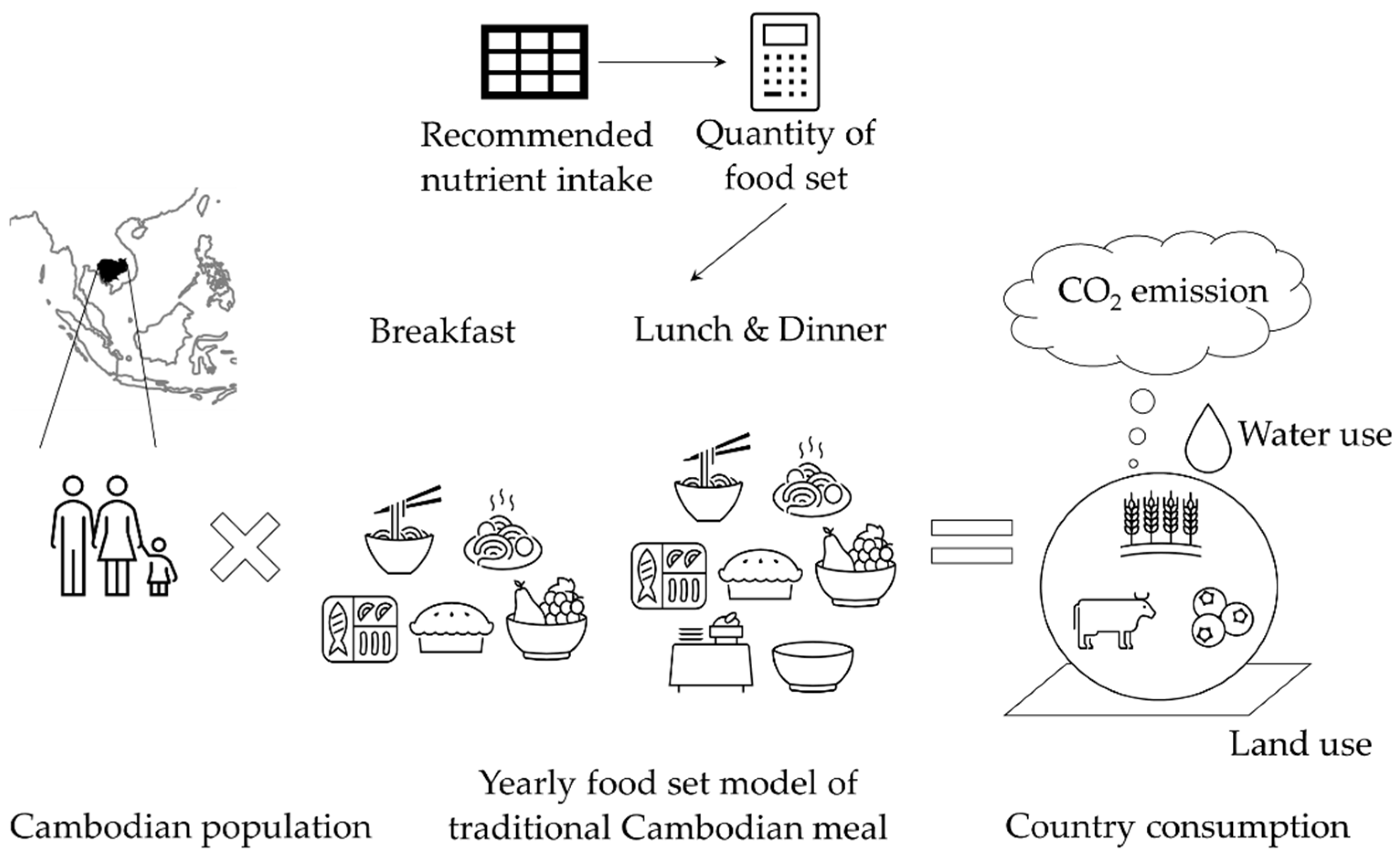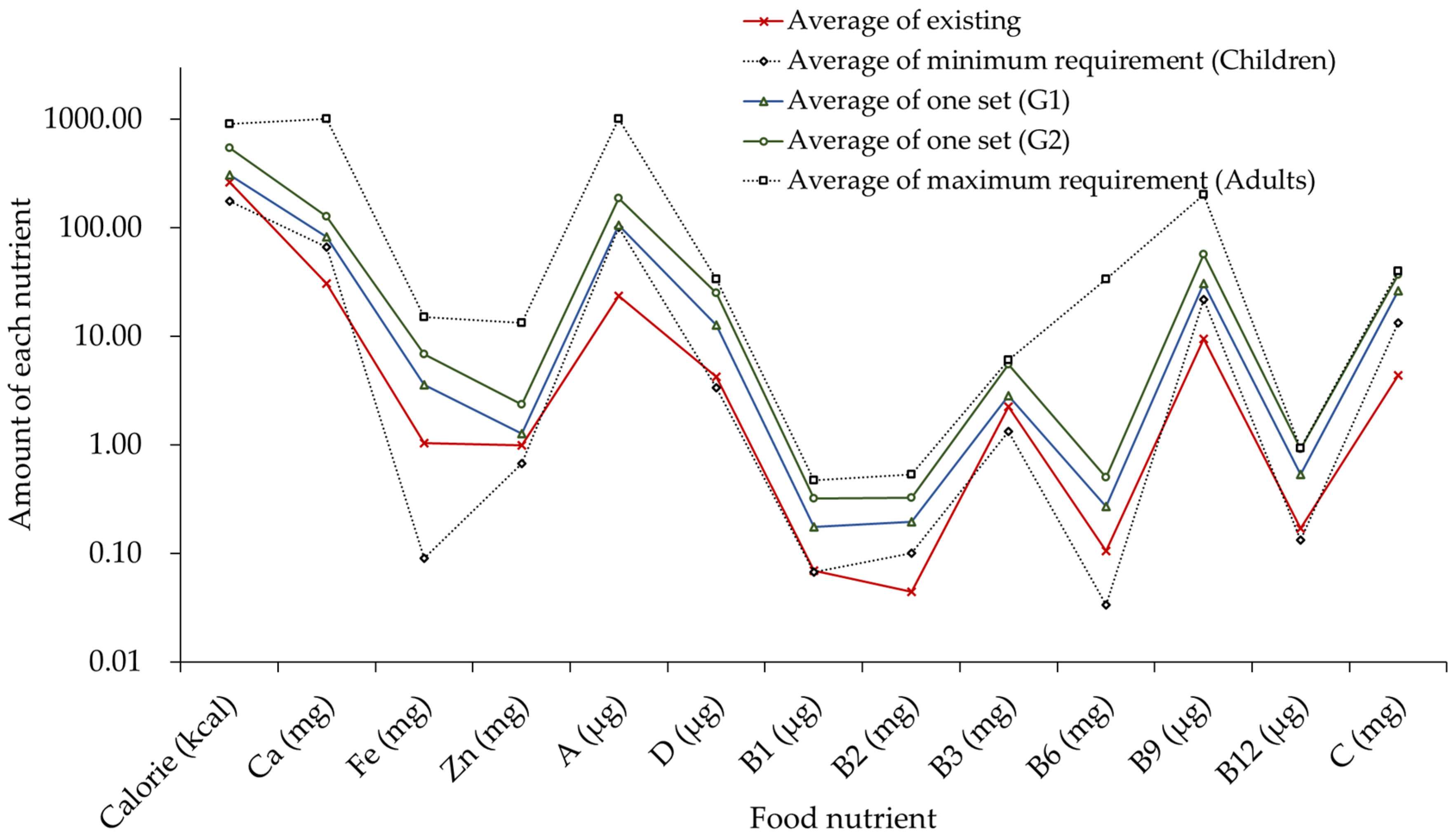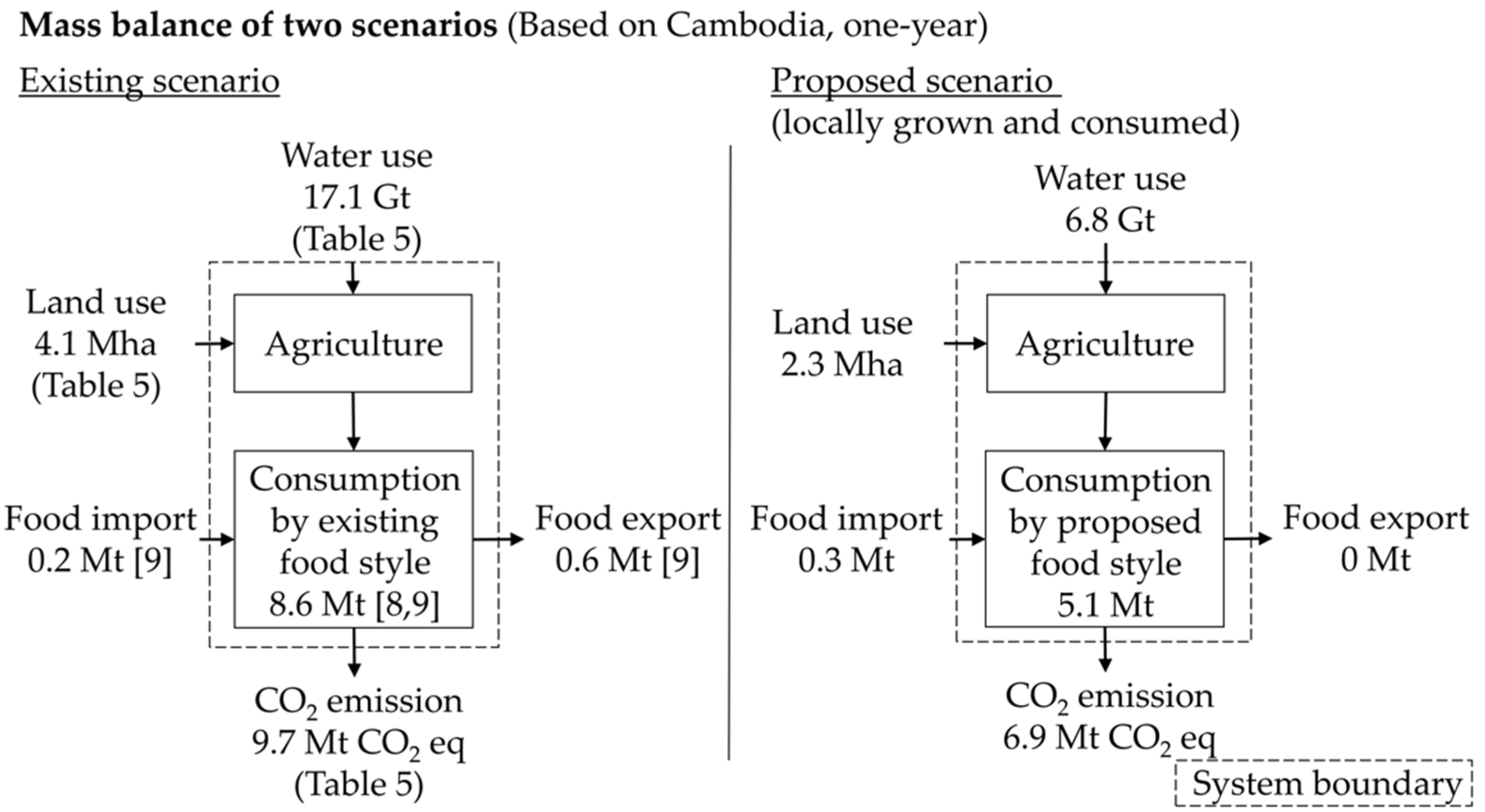3. Results
Traditional Cambodian food sets consist of 12 food sets categorized into five breakfast food sets (BF1–5) and seven lunch and dinner (LD1–7) food sets, which include food for calories, minerals, and vitamins. The food sets of food for calories consist of staple food, food menu, cooking oil, and food eaten for minerals and vitamins, such as vegetables, spices, fruits, and milk. Therefore, the food set called BF1 included chicken congee, fruit, and milk. BF2 consisted of Khmer fish noodle soup, fruit, and milk. BF3 included rice with fried pork, fruit, and milk. BF4 included beef noodle soup, fruit, and milk. Finally, BF5 included a Khmer sandwich, fruit, and milk. LD1 included samlor kako Khmer stew, fruit, and milk. LD2 included beef lemongrass sour soup, fruit, and milk. LD3 included samlor brahaer Khmer stew, fruit, and milk. LD4 included fried fish with ginger, fruit, and milk. LD5 included braised fish with tomato, fruit, and milk. LD6 included waterlily sour soup, fruit, and milk. Lastly, LD7 included stir-fry beansprouts, fruits, and milk. The serving size depended on the consumer’s age. For G1, it was 200–205 g/set, and for G2 it was 330–335 g/set (
Table 3). Therefore, the nutrient requirements include typical food eaten for calories, minerals, and vitamins (
Table A2). Nutrition value is dependent on the food composition, such as carbohydrates, protein, fat, calcium, iron, zinc, vitamin A, vitamin B, vitamin C, and vitamin D (
Table A1). Normally, consumers consume three food sets per day to satisfy the nutrient requirements for their daily life.
Traditional Cambodian food (one set of food) consists of food eaten for calories and food eaten for minerals and vitamins and is dependent on food composition and the quantity of food items eaten. Food eaten for calories (carbohydrate, protein, and fat), minerals (Ca, Fe, and Zn), and vitamins (A, D, B1, B2, B3, B6, B9, B12, and C) is divided into two major categories (BF and LD) and two age groups (
Table 3). The average calorie count of one food set for G1 consumers was 307 kcal/set, which consisted of 50 g of carbohydrate, 11 g of protein, and 6 g of fat. The same food set contains minerals (82 mg of Ca, 4 mg of Fe, and 1 mg of Zn), and vitamins (105 µg of A, 13 µg of D, 0.2 µg of B1, 0.2 mg of B2, 2.8 mg of B3, 0.3 mg of B6, 30 µg of B9, 0.5 µg of B12, and 26 mg of C). Additionally, the average calorie count of one food set for G2 consumers was 540 kcal/set, which consisted of 91 g of carbohydrate, 22 g of protein, 8 g of fat, minerals (127 mg of Ca, 6.8 mg of Fe, and 2.3 mg of Zn), and vitamins (186 µg of A, 25 µg of D, 0.3 µg of B1, 0.3 mg of B2, 5.5 mg of B3, 0.5 mg of B6, 57 µg of B9, 0.9 µg of B12, and 37 mg of C) (
Table 3;
Figure 3). Both consumers went beyond the minimum and maximum food nutrition requirements.
Instead of the food set selection, three sets listed as BF1 + LD1 + LD3 were consumed every day. The results showed foods eaten for calorie intake and foods eaten for mineral and vitamin intake. Thus, food selection could change according to consumers’ preferences. In one day, the G1 consumers consumed 907 kcal of food for calories, which included 153 g of carbohydrates, 35 g of protein, 14 g of fat. Food eaten for minerals included 257 mg of Ca, 5.6 mg of Fe, and 3.3 mg of Zn. Food eaten for vitamins included 328 µg of A, 5.5 µg of D, 0.7 µg of B1, 0.7 mg of B2, 11 mg of B3, 0.9 mg of B6, 82 µg of B9, 1.5 µg of B12, and 77 mg of C. For G2 consumers, the calorie intake per day was 1620 kcal, which included 280 g of carbohydrates, 67 g of protein, and 22 g of fat. Food eaten for minerals included 402 mg of Ca, 9.9 mg of Fe, and 5.9 mg of Zn, and food eaten for vitamins included 588 µg of A, 93.5 µg of D, 1 µg of B1, 1.1 mg of B2, 21.1 mg of B3, 1.6 mg of B6, 150 µg of B9, 2.4 µg of B12, and 108 mg of C.
In the proposed scenario, rice, rice noodles, wheat, chicken, pork, fish, egg, cooking oil, vegetables, fruit, and milk were eaten in amounts of 1.18 Mt, 0.20 Mt, 0.10 Mt, 0.12 Mt, 0.07 Mt, 0.13 Mt, 0.52 Mt, 0.05 Mt, 0.04 Mt, 1.48 Mt, 0.84 Mt, and 0.34 Mt, respectively. Therefore, the proposed scenario consumption was based on the food set and the quantity of food items eaten (
Table 2 and
Table 4;
Figure 4).
The Cambodian GHG emissions of carbon dioxide equivalent from the proposed food set were 6.9 Mt/y. The highest emission was 1.2 Mt for LD2, and the lowest was 0.3 Mt for BF1 and BF2. Therefore, BF4, LD7, and LD1 had emissions of 0.9 Mt, 0.8 Mt, and 0.7 Mt, respectively. Both BF4 and LD4 had emissions equal to 0.5 Mt, and BF5, LD3, LD5, and LD6 had emissions equal to 0.4 Mt (
Figure 5).
The mass balance of the existing and proposed scenarios according to land use, water use, and CO
2 emissions showed the supply to be 8.6 Mt, including an import of 0.2 Mt and an export of 0.6 Mt. Based on the supply, 4.1 Mha for land use, 17.1 Gt for water use, and 9.7 Mt CO
2 eq for emitted CO
2 emissions were required. However, the result for the proposed scenario showed that the consumption was 5.1 Mt, including the import of wheat and milk products. Depending on the supply required, 2.3 Mha for land use, 6.8 Gt for water use, and 6.9 Mt CO
2 eq for CO
2 were emitted (
Figure 6). For the proposed scenario, the result showed the consumption of staple foods, meat, eggs, vegetables, fruits, and milk to be 1.48 Mt, 0.84 Mt, 0.05 Mt, 1.52 Mt, 0.84 Mt, and 0.34 Mt, respectively, with land uses of 0.88 Mha, 0.78 Mha, 0.08 Mha, 0.16 Mha, 0.06 Mha, and 0.38 Mha, respectively, and water uses of 3.00 Gt, 2.38 Gt, 0.03 Gt, 0.17 Gt, 0.13 Gt, and 0.91 Gt, respectively (
Table 5).
For the proposed scenario, the result showed the consumption of staple foods, meat, eggs, vegetables, fruits, and milk to be 1.48 Mt, 0.84 Mt, 0.05 Mt, 1.52 Mt, 0.84 Mt, and 0.34 Mt, respectively, with land uses of 0.88 Mha, 0.78 Mha, 0.08 Mha, 0.16 Mha, 0.06 Mha, and 0.38 Mha, respectively, and water uses of 3.00 Gt, 2.38 Gt, 0.03 Gt, 0.17 Gt, 0.13 Gt, and 0.91 Gt, respectively (
Table 5).
For the total GHG emissions of carbon dioxide equivalent in the existing scenario, the total emissions of carbon dioxide were 9.7 Mt CO
2 eq/yr, in which staple foods, meat, eggs, vegetables, fruits, and milk had values of 5.3 Mt, 2.93 Mt, 0.05 Mt, 0.78 Mt, 0.41 Mt, and 0.24 Mt, respectively. However, in the proposed scenario the total carbon dioxide emissions were 6.9 Mt CO
2 eq/yr, of which staple foods, meat, eggs, vegetables, fruits, and milk had values of 1.12 Mt, 3.16 Mt, 0.09 Mt, 0.99 Mt, 0.28 Mt, and 1.25 Mt, respectively (
Table 5;
Figure 7;
Table A4 and
Table A5).
4. Discussion
In the proposed scenario, the food consumed for calories per one set had an average of 307 to 540 kcal/set (
Table 3;
Figure 3), which was higher than the average in the existing scenario. Moreover, the amount of food consumed for minerals and vitamins in the proposed scenario was the higher than in the existing scenario [
12,
26].
One set had food consumed for calories from 591 to 793 kcal/set, containing 100 to 112 g of carbohydrate, 16 to 30 g of protein, and 12 to 24 g of fat. Then, the minerals included 4 to 12 mg of Fe, and the vitamins included 61 to 799 µg of A, 29 to 477 µg of B9, and 24 g of C [
1,
36,
37,
38].
The food consumed for calories was defined by the consumer age and physical activity [
26,
27,
28,
29,
30]. From 1 to 9 years of age, the food consumed for calories was between 1180 and 1825 kcal/day [
24]. From 1 to 5 years of age, the food consumed for calories was between 950 and 1300 kcal/day. Therefore, from 6 to over 80 years old, the food consumed for calorie intake was defined according to the physical activity level [
28]. Food consumed for minerals and vitamins was defined between the minimum and maximum requirements [
29,
37]. The individual intake guideline includes 5–12 g of carbohydrate/set/kg body weight, 1.2–1.8 g of protein/set/kg body weight dependent on physical activity, and 20–30% of the total calories required [
39]. The food consumed for calories and the food consumed for minerals and vitamins was beyond the minimum and maximum requirements (
Table A2).
In the existing scenario, food items consisted of rice, wheat, meat, eggs, cooking oil, vegetables, fruits, calcium as milk, and fish. The Cambodian data in 2017 [
9] showed that the food supply of each food item was equal to the demand and other (processing, feed, seed, non-food, and stock) was equal to the production and import, excluding export. The rice was required 6.17 Mt/y of supply. The wheat, beef, chicken, pork, fish, eggs, cooking oil, vegetables, fruits, and milk accounted for 0.04 Mt, 0.07 Mt, 0.04 Mt, 0.10 Mt, 0.69 Mt, 0.02 Mt, 0.05 Mt, 0.55 Mt, 0.77 Mt, and 0.06 Mt, respectively. We do not have data concerning rice noodles yet (
Figure 4;
Table A3). According to the Ministry of Health and the Foundation for International Development/Relief, individuals of ages from 6 to 17 years old in a rural area consumed 74.6% carbohydrates, 11% proteins, and 14.4% fats. However, in an urban area they consumed 70.5% carbohydrates, 11.8% proteins, and 17.7% fats [
26]. Moreover, the annual food intake per person was 300 kg of rice, 27 kg of meat, 27 kg of fish, and 91 kg of vegetables [
34]. The total food consumption in the proposed scenario was less than in the existing one.
According to the food set, land and water use for plantation and raising and emissions of carbon dioxide equivalent (CO
2 eq) were estimated. For the existing scenario, the rice produced 6.17 Mt and required 2.79 Mha of land use [
8,
9] and 13.88 Gt of water use [
19]. Data for rice noodles have not yet been reported [
8,
9]. The consumption of wheat, meat, egg, vegetables, fruit, and milk was 0.04 Mt, 0.09 Mt, 0.02 Mt, 0.60 Mt, 0.77, and 0.06 Mt, respectively, with land uses of 0.11 Mha, 0.93 Mha, 0.04 Mha, 0.09 Mha, 0.06 Mha, and 0.06 Mha, respectively, and water uses of 0.02 Gt, 2.86 Gt, 0.01 Gt, 0.08 Gt, 0.12 Gt, and 0.15 Gt, respectively (
Table 5;
Figure 7).
In the proposed scenario, the average for G1 and G2 per week was emitted CO
2 eqs of 5.42 kg/week and 9.47 kg/week, respectively (
Table A5), which were lower than the values for the Mediterranean and new Nordic diets. However, the Mediterranean and new Nordic diets had emitted carbon dioxide emissions of 23.56 kg CO
2 eq/week and 25.8 kg CO
2 eq/week, respectively. These emissions were calculated from the individual food categories of beef, egg, milk, margarine, potatoes, pasta, assorted fruits, and tap water [
24]. Therefore, the carbon dioxide emissions per product, including cereal, rice, beef, chicken, pork, fish, egg, butter, vegetable, fruit, and milk, were 0.50 kg, 2.55 kg, 26.61 kg, 3.65 kg, 5.77 kg, 3.49 kg, 3.46 kg, 9.25 kg, 0.37 kg, 0.42 kg, and 1.29 kg, respectively [
19]. The emissions from fast food, pizza, were 3.5 kg CO
2 eq/kg pizza, in which cheese, meat, and solid fat made up 43%, 21%, and 21%, respectively [
40]. Therefore, the dairy emissions were 0.37 kg CO
2 eq. Therefore, the global warming potential of carbon dioxide emissions were 1.09 kg for a ready meal and 0.99 kg for homemade chicken. The ready meal, tomato pasta, caused 0.12 kg, and the home made meal caused 0.11 kg [
41]. However, in the proposed scenario the CO
2 eq kg/kg was higher than the emissions from ready meal, tomato pasta, and homemade chicken.
The global GHG emissions by sector were 49.4 billion t CO
2 eq, which included energy, industry, waste, and agriculture and land use at amounts pf 73.2%, 5.2%, 3.2%, and 18.4%, respectively. The global land use for livestock (meat and dairy) and crops was 77% and 23% of all agricultural land, accounting for 18% and 82% of calories supplied, and 37% and 63% of the protein supply, respectively [
19]. Consequently, the global GHG emissions from non-food and food were 74% and 26%, respectively. The supply chain emissions, livestock and fish farms, crops, and land uses were 18%, 31%, 27%, and 24% of food, respectively. In the supply chain, the GHG emissions were high, accounting for high carbon dioxide equivalents from farms per kilogram of product. Instead of beef, the total GHG emissions were 60 kg CO
2 eq/kg product, which included land use, animal feed, farm, processing, transport, packaging, and retail of 16.3 kg, 1.9 kg, 39.4 kg, 1.3 kg, 0.3 kg, 0.2 kg, and 0.2 kg, respectively. Moreover, the total GHG emissions from pig meat, poultry meat, fish (farm), other vegetables, and other fruits were 7.2 kg, 6.1 kg, 5.1 kg, 0.5 kg, and 0.7 kg, respectively [
19]. In Cambodia, the 2016 carbon dioxide emissions equivalent was 65.6 Mt, which included emissions from agriculture, land use change and forestry, transport, and other (bunker fuel, industry, waste, building, electricity, and heat, fumes from energy production, construction energy, and other types of fuel combustion) of 21.0 Mt, 30 Mt, 5.0 Mt, and 9.6 Mt, respectively [
20]. Therefore, in Cambodia the 2016 GHG emissions for agriculture, land use change and forestry, other fuel combustion, waste, and fugitive emission and industry were 17.09 Mt, 5.37 Mt, 2.8 Mt, 0.28 Mt, and 0 Mt for methane emissions, respectively, and 3.89 Mt, 1.88 Mt, 0.67 Mt, 0.26 Mt, and 0 Mt for nitrous oxide, respectively [
20]. According to Ritchie and Roser, the per person methane emissions of CO
2 eq based on their global warming potential value over a 100-year timescale was 1.62 Mt. Therefore, the total methane emissions from the rice field were 0.38 Mt [
19,
21,
35,
42,
43]; in Cambodia, the total emissions from the paddy field were 0.45 Mt for methane emissions and 9.37 Mt for carbon dioxide emissions. Moreover, the total emissions (enteric) from all animals were 0.18 Mt for CH
4 emissions, and the CO
2 eq was 3.74 Mt [
9].
In a comparison between the existing and proposed scenarios, the results showed that the carbon dioxide emissions are expected to reduce from 9.7 Mt in the existing scenario to 6.9 Mt in the proposed one. The land use requirement is reduced from 4.1 Mha in the existing scenario to 2.3 Mha in the proposed scenario, and the water use requirement is reduced from 17.1 Gt in the existing scenario to 6.8 Gt in the proposed one.
5. Conclusions
This research focuses on food consumption for traditional Cambodian food. The food set was defined as the quantity of rice, rice noodles, wheat, beef, chicken, pork, fish, eggs, cooking oil, vegetables, spices, fruits, and milk consumed. Depending on the food consumption in the proposed scenario, the land and water use requirements were reduced by 43.90% and 60.23%, respectively, for agricultural plantation and raising animals to meet the nutrient requirement intake.
The assessment was performed using existing practices and the proposed scenario was divided into BF and LD sets. In these sub-categories, food was divided into two scenarios: food eaten for calories and food eaten for minerals and vitamins. In the proposed scenario, the food eaten for calories, minerals, and vitamins satisfied the food requirements. The carbon dioxide emissions for the traditional Cambodian food set were decreased by 28.87%. Therefore, the food eaten for calories, minerals, and vitamins met the food set quantity requirements. The food set emissions were calculated from the food item intake.
In the proposed scenario, there is an opportunity to reduce land and water use, and the CO2 of the agricultural production system met the nutrient requirements for human health. Furthermore, the LCA-based analysis showed the effectiveness of adopting a diet rich in traditional Cambodian foods to reduce the environmental load for CO2 emissions. This method calculates dietary intake based on food eaten for calories, minerals, and vitamins.














